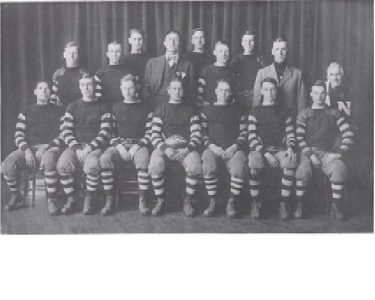Projects
"Coach Says Ross Will Play": The 1913 Protests by Kansas and Kansas StateProject Editor: Bradley Earley, History 470: Digital History, Spring 2008

| The 1913 Nebraska Cornhusker Football Team |
A Brief Overview.
The first game in Nebraska football history was played on Thanksgiving Day in 1890. A delegation from the student population, number almost 500, accompanied a 12-man roster to Omaha to face a team from the Omaha YMCA. The Boys from Lincoln defeated the Omaha YMCA team by a score of 10-0. Thus was the merger beginnings of what would become 'King Football' at the University of Nebraska. Over the next several years the football team would play Iowa, Doane, Missouri, Kansas, and Kansas State. It was not until 1892 that the team would have a full time coach.
Throughout the storied history of the University of Nebraska's football program there have been many student athletes to compete on the field of battle. In the early years of the program the majority of players were white. The University, however, was not an institution were racism was much of an issue. Because of this early liberal thinking at the University there would be two cases of racial prejudice surrounding the football team and the protest of a football player just because of the color of his skin, but these protests were not from the University of Nebraska, they were from other Institutions.
The first player who would be protested was George Flippin (). The first African-American player to attend the University of Nebraska was George Flippin, who played football from 1891-1895. In 1892, just two years after the first football game to be played at the University of Nebraska, George Flippin's play was protested by Missouri and again in 1893 by the Denver Athletic Club, which they refused to complete because of the participation of Flippin. In an article by David Ochsner, he states, "Denver had a special pick on him (Flippin). He was kicked, slugged and jumped on, but never knocked out, and gave as good as he received" (George Flippin Did It His Way, page 28). This statement shows how resolute Flippin was when it came to playing and being a person that his teammates could depend on even when adversity was against them.
After Flippin left Nebraska he went on to attend the University of Illinois where he studied to become a doctor. He then moved back to Nebraska and started the hospital in Stromsburg. He was married twice, the first resulted in two children and the second was to a white nurse, Mertina Larson that worked at the hospital. The resulting marriage to Miss Larson brought about a lot of attacks both in the private and public sectors. Just as he had dealt with the adversity on the football field, he also took on the attacks after his marriage to Miss. Larson. Everything that George Flippin went through paved the way for the next generation of African-American players at the University of Nebraska. the second plater that would be protested was Clinton Ross ().
|

